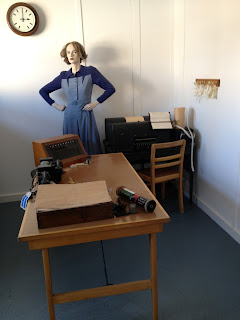As well as the main house, there are many other buildings dotted around the grounds. Most of them are large huts which were built and used during the war. Each had a different purpose and were occupied by civilian, RAF and Navy personel. Sadly most of the huts are in a really sad state of repair, but the trust is hoping to raise the money to restore them. On all the huts that are in need of repair, are posters explaining their situation.
I love them. Such a great idea. :)
There are about 5 or 6 huts that have been restored but only 3 are open to the public. One is used as a lecture/talk room, another as the cafe and the 3rd has been restored to how it would have looked during the war (well most of it has)
This is the cafe, which was was in the old Naval Intelligence hut. In both look, furniture and food it reminded my decidedly of my old prep school dining hall (except the food, which was much better here then at my school).
I didn't take any pictures of the lecture room hut as it was just an empty room with modern chairs, but I did of the 3rd restored hut. It was either hut 3 or hut 8, I can't completely remember which one it was. Anyway here are some photos of the interior.
This is the codebreaker Alan Turing's office. He was an amazing man who, it is said, shortened the war by 2 years.
Apparently Turing was paranoid about people stealing his coffee mug, so he chained it to the radiator in his office. (This mug isn't the original one).
Another office was full of what I think are typex machines. I really should have written this post as soon as I came back from Bletchley as my memory is appalling!)
The switch board room with some rather scary mannequins!
Another room was full of information and artefacts relating to the use of carrier pigeons during the war. This box could hold 2 pigeons.
This one could hold one.
as could this one.
An example of the type of cases that contained messages and were strapped to the leg of a pigeon
More cases
Examples of how the cases were colour-coded.
The sheets the messages were written on.
A pigeon parachute!!!
























Enjoyed part 2 as well!
ReplyDeleteThe typewritery things you refer to are a selection of teleprinters - kind of a precursor to the fax machine. We do have a TypeX machine, but it's very securely locked in a glass cabinet in the main museum!